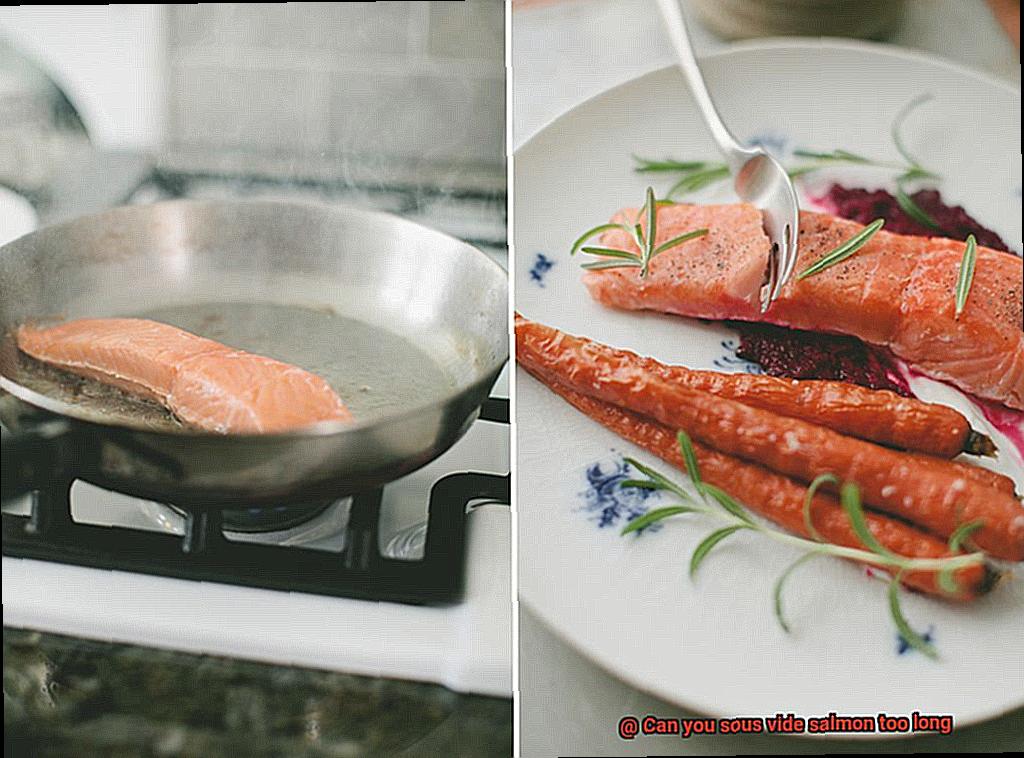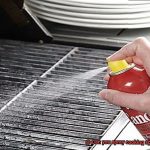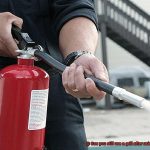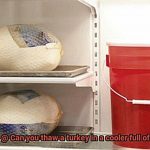Do you love cooking salmon at home? If so, have you tried using the sous vide method? It’s a fantastic way to cook fish with minimal effort. But, like any other cooking method, it’s possible to overcook your salmon.
Overcooking salmon can lead to an unpleasant texture and taste. So, how long is too long when it comes to sous vide salmon? In this blog post, we’ll answer the burning question: “Can you sous vide salmon too long?” We’ll also share tips on how to tell if your fish is overcooked and how to avoid it altogether.
Whether you’re a seasoned pro or new to sous vide cooking, perfecting your salmon recipe is essential. So grab your apron and get ready to learn about the dos and don’ts of cooking sous vide salmon. Let’s dive in.
Contents
What is the Risk of Cooking Salmon Sous Vide Too Long?
Sous vide cooking has become a go-to method for many home chefs seeking precision and consistency in their dishes. When it comes to cooking salmon sous vide, however, there are risks involved if you’re not careful. One of the main risks is overcooking, which can result in a dry and tough texture.
To avoid this unfortunate outcome, it’s essential to pay close attention to both the cooking time and temperature. The ideal temperature for salmon cooked sous vide is around 115-120°F (46-49°C) for a medium-rare finish. Cook it for too long, and the texture can become rubbery and unappetizing. The longer the fish cooks, the more its proteins coagulate and push out moisture. This results in a less-than-optimal eating experience that no one wants to endure.
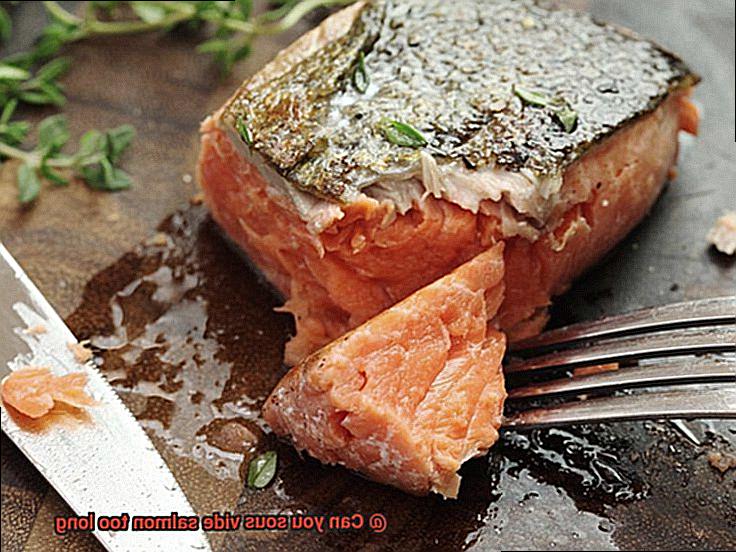
Another risk of cooking salmon sous vide too long is the potential development of harmful bacteria. Although sous vide cooking can effectively pasteurize food by heating it to a specific temperature for a certain amount of time, if the salmon is left in the water bath for an extended period, there is a risk that bacteria could grow. This is especially true if the temperature of the water bath drops below the recommended range or if the fish wasn’t properly sealed before cooking.
To ensure a perfectly cooked and safe-to-eat salmon sous vide, it’s recommended to use high-quality, fresh salmon and season it properly before cooking. It’s also important to follow proper sous vide guidelines and not leave the fish in the water bath for too long. Here are some other tips to keep in mind:
- Always use a reliable thermometer to monitor the temperature of the water bath.
- Avoid overcrowding the bag when vacuum sealing the salmon. This can lead to uneven cooking.
- Consider adding aromatics like herbs, citrus, or garlic to enhance the flavor of your salmon.
- If you’re new to sous vide cooking, start with a smaller piece of salmon to get a feel for the process before attempting larger cuts.
Factors to Consider When Setting the Temperature and Time for Sous Vide Salmon
Then pay attention to the crucial factors that can make or break your dish. As a sous vide expert, I’m here to guide you through the process of setting the right temperature and time for your salmon.
Let’s start with thickness. A thicker fillet will require more time to cook all the way through, so adjust your cooking time accordingly. For fillets up to 1 inch thick, aim for a cooking time of around 45 minutes. But if you have a thicker fillet, up to 2 inches thick, then it can take up to 90 minutes to cook. Remember, precision is key in sous vide cooking.
Temperature is another crucial factor in achieving the perfect salmon texture and flavor. Depending on your preference, set your sous vide machine to a temperature between 118°F-140°F. For medium-rare, aim for a temperature between 118°F-122°F. For medium, set it from 124°F-128°F. And for well-done, go for a temperature of 130°F-140°F. Don’t be afraid to experiment with different temperatures to find your ideal sweet spot.
Texture is also an important consideration when setting the cooking time and temperature. If you prefer a firmer texture, then choose a higher temperature and shorter cooking time. But if you like your salmon soft and tender, then go for a lower temperature with longer cooking time. The beauty of sous vide cooking is that you can customize the texture to your liking.
Lastly, don’t forget that sous vide cooking times can vary based on factors such as altitude or water displacement. That’s why monitoring the temperature throughout the cooking process using a reliable thermometer is crucial to ensure that your salmon is cooked to perfection.
Proper Technique for Cooking Salmon Sous Vide
Temperature is crucial when it comes to cooking salmon sous vide. The sweet spot for medium-rare to medium doneness is between 115°F and 125°F (46°C to 52°C). Going beyond this range can lead to a dry and overcooked salmon, which is a big no-no.
Timing is also of the essence. While salmon can be cooked sous vide for up to an hour, we recommend cooking it for around 30 minutes, depending on its thickness. Overcooking can result in a mushy texture that nobody wants.
Proper seasoning is key to elevating the flavors of the salmon. A simple combination of salt, pepper, and lemon zest can do wonders. But if you want to take it up a notch, try adding some aromatic herbs like dill or garlic for a complex and delightful taste.
Once seasoned, vacuum-seal the salmon in a bag and place it in the water bath at your desired temperature. Make sure the bag is fully immersed in the water for even cooking.
To recap: precise temperature control, timing, and proper seasoning are essential when cooking salmon sous vide. Follow these steps and impress your guests with a tender and moist salmon that’s bursting with flavor.
Tips to Avoid Overcooking Salmon Sous Vide
Sous vide cooking has become a popular method for cooking salmon due to its ability to produce perfectly cooked fillets with a tender texture and rich flavor. However, overcooking can be a common issue that results in dry and tough fish. Here are five tips to help you avoid overcooking your salmon sous vide and achieve perfectly cooked fillets every time.
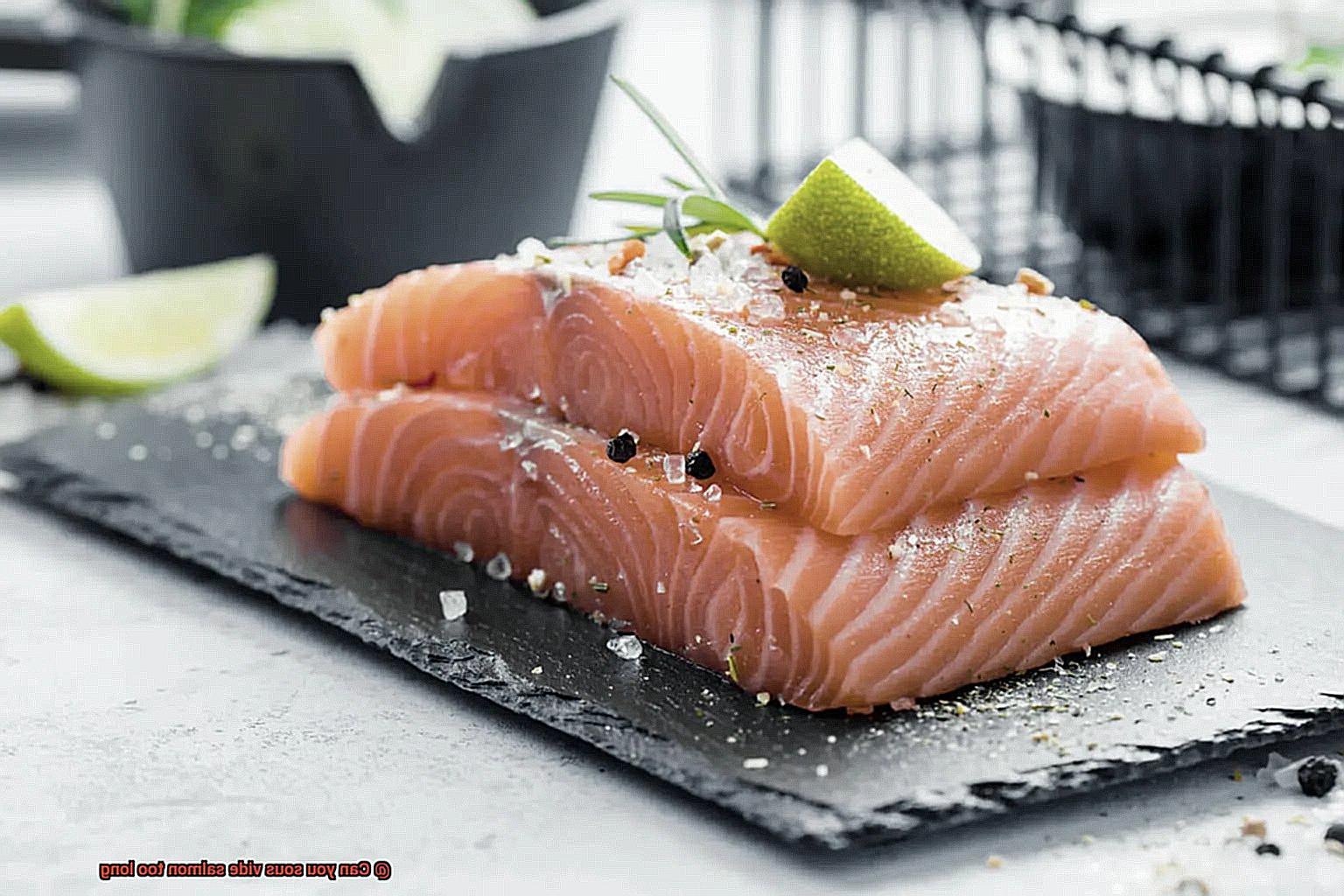
Set the Right Temperature
Temperature is a crucial factor when cooking salmon sous vide. To avoid overcooking, set your water bath temperature to no more than 130°F (54°C) for medium-rare or 140°F (60°C) for medium. Cooking for longer than the recommended time can result in dry and tough salmon. Monitor the temperature of the water bath regularly and adjust as necessary.
Use Thicker Cuts of Salmon
Thicker cuts of salmon hold up better during the cooking process and are less likely to become overcooked and dry out quickly. It’s recommended to use salmon fillets that are at least one inch thick to achieve perfectly cooked fillets.
Season Before Cooking
Seasoning your salmon before cooking is an excellent way to enhance its flavor. However, be careful not to use too much salt, as this can draw out moisture from the fish and result in a dry texture. Instead, try using herbs, spices, or a simple marinade to add flavor to your fish.
Check the Cooking Time
The optimal cooking time for salmon varies based on the thickness of the fillet. As a general rule of thumb, aim for a cooking time of 45 minutes for every inch of thickness. Be sure to check the timer regularly and remove the salmon from the water bath promptly once it has finished cooking.
Pat Dry After Cooking
Once your salmon is finished cooking, remove it from the water bath immediately and pat it dry with a paper towel. This will prevent any residual heat from continuing to cook the fish and ensure that it stays moist and tender. Additionally, you can sear the fillet in a hot pan or with a blowtorch for a crispy outer layer.
Benefits of Using a Sous Vide Recipe or Guide
By using a sous vide recipe or guide, you can guarantee that your salmon will turn out perfect each time.
One of the most significant benefits of using a sous vide recipe or guide is precision. Traditional cooking methods can be inconsistent when it comes to achieving the desired level of doneness. However, with sous vide cooking, you have the ability to set and maintain the temperature and time precisely throughout the cooking process. This ensures that your salmon is cooked to perfection, with no guesswork involved.
Another advantage of sous vide cooking is convenience. Once you have sealed your salmon in a vacuum-sealed bag and placed it in the water bath, there’s no need to keep a constant eye on it or flip it like with traditional methods. This allows for a more hands-off approach and frees up your time to focus on other aspects of meal preparation.
Using a sous vide recipe or guide also provides endless options for flavoring and seasoning your salmon. The vacuum-sealed bag locks in all the added marinades and seasonings, allowing them to infuse deeply into the flesh and resulting in a more flavorful end product.
How Thickness Affects the Cooking Time for Salmon
Before you dive into the world of sous vide salmon, it’s vital to understand how thickness affects cooking time.
The thickness of your salmon filet can significantly impact the cooking time when using sous vide. The heat from the water bath needs to penetrate the entire piece of fish to cook it correctly. As a general rule, the thicker the salmon filet, the longer it will take to cook.
For instance, a 1-inch thick salmon filet may take around 40-45 minutes to cook in a sous vide water bath set to 130°F, while a thinner filet that is only ½ inch thick may only need 25-30 minutes at the same temperature.
But bear in mind that cooking times can vary based on multiple factors, including water bath temperature and starting fish temperature. Additionally, if you are cooking multiple pieces of salmon at once, you may need to adjust your cooking time accordingly.
To ensure that your salmon is cooked to perfection every time, use a kitchen thermometer to check its internal temperature before serving. The FDA recommends cooking fish to an internal temperature of 145°F, but many sous vide enthusiasts prefer slightly lower temperatures for a more tender and juicy texture.
How to Tell if Your Salmon is Overcooked
Sous vide cooking is a precise and effective method of cooking salmon, but overcooking is still a possibility. Overcooking salmon can result in a dry, tough texture, and loss of flavor. Therefore, it is crucial to understand the risks of overcooking salmon sous vide.
One of the main risks of overcooking salmon sous vide is that it can become mushy and lose its natural texture and flavor. This can happen if the temperature is set too high or if the cooking time is too long. It’s essential to remember that the exact cooking time and temperature will depend on the thickness of the salmon fillet, so it’s important to pay attention to these factors.
Checking the Texture of the Salmon
One way to determine if your salmon is overcooked during sous vide cooking is by checking its texture. Ideally, cooked salmon should be tender and moist. If it flakes easily with a fork, it is cooked perfectly. On the other hand, if it falls apart or crumbles, it may have been cooked for too long.
When you remove your salmon from the water bath, gently press on it with a fork or tongs. If you notice that the flesh has become mushy or stringy, it may be overcooked and dry.
Observing the Color of the Salmon
Another way to tell if your salmon is overcooked during sous vide cooking is by observing its color. A perfectly cooked salmon should have a vibrant pink color and still be translucent in the center. If it appears opaque throughout, it may have been overcooked.
When you remove your salmon from the water bath, take a close look at its color under bright light. If you notice that it has turned white and opaque throughout, it may be overcooked.
Checking the Internal Temperature of the Salmon
To avoid overcooking your salmon during sous vide cooking, it’s important to follow the recommended cooking times and temperatures. The ideal temperature range for cooked salmon is between 120-130°F. If your salmon’s internal temperature exceeds 140°F, it has been overcooked and will likely have lost its moisture and tenderness.
When you remove your salmon from the water bath, use a meat thermometer to check its internal temperature. If it exceeds 140°F, it may have been cooked for too long.
Paying Attention to the Taste of the Salmon
Lastly, pay attention to the taste of your salmon. Overcooked salmon can taste dry and bland, lacking the natural flavors and moisture that make it so delicious. If you notice that your salmon is lacking its natural flavors or tastes tough and dry, it may have been overcooked.
Conclusion
In summary, sous vide cooking is a fantastic way to cook salmon with precision and consistency. However, it’s crucial not to overcook the fish, resulting in an unpleasant dry and tough texture. To avoid this outcome, it’s imperative to pay close attention to both the temperature and cooking time.
For the perfect medium-rare finish, salmon cooked sous vide should be at around 115-120°F (46-49°C). Cooking it for too long can result in rubbery and unappetizing fish. As proteins coagulate and push out moisture during prolonged cooking times, it’s best to keep a watchful eye on your salmon.
It’s also essential to follow proper sous vide guidelines by not leaving your fish in the water bath for too long. Using a reliable thermometer to monitor the temperature of the water bath is crucial.
To ensure that you cook perfectly cooked and safe-to-eat salmon sous vide every time, start with high-quality fresh salmon. Be sure to season it adequately before cooking and avoid overcrowding the bag when vacuum sealing your salmon. Consider adding aromatics like herbs or garlic to enhance flavor further.
If you’re new to sous vide cooking, starting with a smaller piece of salmon can help you get comfortable with setting the right temperature and timing for your recipe or guide.

